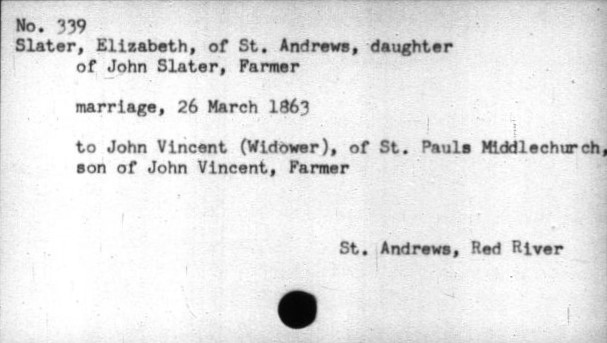For those unfamiliar, Canadiana is a huge digitization project to provide free access to newspapers, serials, books and government publications. It's sister site Heritage is free access to digitized microfilms held mainly by Library and Archives Canada. They are constantly adding to the site, so I like to periodically delve into it to see what I can find. I'm never disappointed.
All three rolls are under the heading Parish registers: Manitoba. The three microfilm numbers are H-1344, H-1812, and H-1813.
H-1344
This microfilm consists of index cards compiled by Clarence Kipling. According to Library and Archives Canada's website, the collection contains about 4,000 index cards of records from the churches of the Red River Settlement. The microfilm however, shows over 5,000 images. The reason for this is that there is part of a second set of index cards at the tail end of the reel. These index cards are finding aid cards made by the LAC for the collection. The Kipling index cards end at image 4301. The Kipling cards are arranged alphabetically by surname. They give person's name, and the baptism during that person's life. This is the scope and content of the collection, according to the LAC website:
"...The series consists of approximately 4,000 cards prepared by Clarence Kipling from the parish registers of the Red River Settlement: St. John's Anglican Church, 1820-1884; St. Andrew's Anglican Church, 1835-1884; and St. Boniface Roman Catholic Church, 1824-1834. The entries for St. John's Anglican Church include marriages for 1820-1878 and 1881-1882; and deaths for 1821-1823, 1825-1838, and 1841-1875. The entries for St. Andrew's Anglican Church include marriages for 1835-1876 and 1878-1883; and deaths for 1835-1876 and 1878-1884. The entries for St. Boniface Roman Catholic Church include baptisms for 1824-1825, 1829-1830, and 1832-1834; and marriages and deaths for 1825, 1828-1830, and 1832-1834. Library and Archives Canada does not hold the original registers to which this index relates, but the index cards contain transcripts of the information supplied by the registers. The cards originally numbered about 3,100 but additional cards were made for brides (who were not originally noticed separately from the bridegroom) and for any cards which contained multiple entries. The index cards were removed from the LAC reference room in 2009 for digitization, and vault storage in four containers: R4084, volumes 1 to 4. The cards are filed in alphabetical order: volume 1 holds surnames A to F, volume 2 holds surnames F to M, volume 3 holds surnames M to S, and volume 4 holds surnames S to Z...." https://collectionscanada.gc.ca/pam_archives/index.php?fuseaction=genitem.displayItem&rec_nbr=115305&lang=eng&rec_nbr_list=115304,115306,115305
Some of the cards are typed, while others are handwritten. They can contain quite a bit of information. Here's one for Angelique Zoste, baptized 10 June 1832
Here's the marriage of Elizabeth Slater to John Vincent 26 March 1863
And here's the burial of James Cowley on 13 Feb 1849
H-1812
This microfilm has 4 sets of parish records. I'm only going to concentrate on the first two.
The Winnipeg District images are a hodge podge of records from different churches. Unfortunately, the images are not of the best quality, but are still readable.
The Holy Ghost Parish collection is fascinating. The parish is the oldest Polish Roman Catholic parish in Western Canada. Included in the collection are baptismal certificates issued in Eastern Europe. If your immigrant ancestor was in this parish, what a fantastic find for you!
H-1813
This microfilm deals with the work of the Rev. James S Stewart, a Presbyterian missionary. The microfilm contains not only BMD's from his Manitoba ministry. This microfilm also gives some great insight into the life of a missionary in the late 1800's. It contains his notes from seminary schooling, and other little bits of the mundane in his professional work. If you wanted an insight in what a missionary's life was like, then it is quite informative. If you looking only for BMD information, then you'll want to concentrate on images in the last half of the roll. There are financial sheets as well, naming individual parishioners.









What an amazing find. Thanks for letting us know.
ReplyDelete